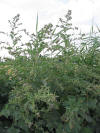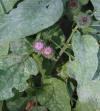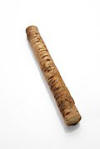WILD
FOODIES' HOME PAGE
PLANT PROFILE LIST
NAME: Burdock
SPECIES / FAMILY: Arctium Minus / Asteraceae or Compositae
OTHER COMMON NAME(S): lessor burdock, wild rhubarb
CONDITIONS:
sun/partial shade, moist soil
|
PARTS: |
EDIBLE |
TASTE |
RAW/COOK |
SEASON |
|
All |
|
|
|
|
|
Shoots |
|
|
|
|
|
Leaves |
|
COOK |
Spring |
|
|
Stalk/Stem |
|
|
PEEL/RAW/COOK |
Spring |
|
Buds |
||||
|
Flowers |
|
|
|
|
|
Fruits |
|
|
|
|
|
Pods |
|
|||
|
Seeds |
|
|
SPROUTED |
Summer |
|
Nuts |
|
|
|
|
|
Roots |
|
artichokes |
RAW/COOK |
Fall |
|
Bark |
|
|
|
|
PORTION: medium
COMMENT: Burdock is in the thistle family, along with artichokes; which is what they taste like. Eat only first-year small roots, not second-year or big roots whose fibers are too stiff and rough. Soak root for 24 hours with one change of water before cooking to reduce flatulence. I boil the roots for one hour, but still get gas. Some people suggest pickling them to aid in digestion; others roast them. It appears that you can boil second hear Burdock root if all you want is the broth to drink. The cooked roots are delicious, taste just like artichoke hearts, should be peeled and cooked thoroughly and 'cut width-wise' to avoid fibrous texture. Roots of Burdock and Dandelion were one of the first root beers. // The roasted root is a coffee or tea substitute. Leaf and stems are mucilaginous. Best to remove the rind from the stem. Young flowering main stem and leaf stems are a celery substitute - peeled and eaten raw or cooked like asparagus. Seed sprouts.” (1) When making tea from the root, the water can turn blue, some say depending on the acidity of the water - http://www.normanallan.com/Med/herbs/burdock.htm
Boiled
Burdock Root in combination with wild rice, mushrooms, and cooked greens is
delicious!
CAUTION:
“Although no reports
of toxicity have been seen for this plant, some caution is advised due to the
following report for the closely related A. lappa. Care should be taken if
harvesting the seed in any quantity since tiny hairs from the seeds can be
inhaled and these are toxic.”(1)
NUTRITION/MEDICINAL: “Burdock is one of the foremost detoxifying herbs in both Chinese and Western herbal medicine. Arctium lappa is the main species used, though this species has similar properties. The dried root of one year old plants is the official herb, but the leaves and fruits can also be used. It is used to treat conditions caused by an 'overload' of toxins, such as throat and other infections, boils, rashes and other skin problems. The root is thought to be particularly good at helping to eliminate heavy metals from the body. The plant is antibacterial, antifungal and carminative. It has soothing, mucilaginous properties and is said to be one of the most certain cures for many types of skin diseases, burns, bruises etc. It is used in the treatment of herpes, eczema, acne, impetigo, ringworm, boils, bites etc. Alterative; Antibacterial; Antifungal; Aperient; Blood purifier; Carminative; Cholagogue; Diaphoretic; Diuretic; Hypoglycaemic.” (1)
o https://www.webmd.com/vitamins/ai/ingredientmono-111/burdock
o https://draxe.com/nutrition/burdock-root
LOOK-A-LIKES: Many other related species - http://www.luontoportti.com/suomi/en/kukkakasvit/greater-burdock
POISONOUS LOOK-A-LIKES:
OTHER USES: “Paper. A fibre is obtained from the inner bark and is used to make paper. It is about 0.9 mm long. The stems are harvested in late summer, the leaves are removed and the stems steamed in order to strip off the fibre. The fibres are then cooked for two hours in soda ash before being put in a ball mill for 2 hours. The resulting paper is a light tan/ brown colour.”(1)
SOURCE LINKS (may include nutritional and medicinal info, plus other uses):
- https://pfaf.org/user/Plant.aspx?LatinName=Arctium+minus (also see: https://pfaf.org/user/plant.aspx?LatinName=Arctium+lappa)
- http://www.eattheweeds.com/?s=burdock
- https://en.wikipedia.org/wiki/Arctium_minus & https://en.wikipedia.org/wiki/Arctium
- http://www.foragingtexas.com/2007/11/burdock.html (good photos)
- http://www.ediblewildfood.com/burdock.aspx (good photos)
- https://cheflynnmiller.wordpress.com/2012/10/08/burdock-the-late-great-mis-understood-starch (recipes)
- http://foragedfoodie.blogspot.com/2017/03/burdock-and-pokeweed-fritters.html (recipes)
- https://www.seriouseats.com/recipes/2018/10/wild-rice-salad-with-mushrooms-celery-root-and-pine-nuts.html
- https://toirokitchen.com/blogs/recipes/earthy-burdock-root-rice
-
http://www.normanallan.com/Med/herbs/burdock.htm
-
a wonderful method for brewing Burdock tea - cut
off about a 2 inch segment of the root. Slice it in half (or possibly
quarters). Cover with water (2 to 6 cups, half a pint, half a liter -
approximately). Bring to a boil, then let it steep. As it cools off the tea
will turn blue. You can add more water and brew a second, a third batch,
till it loses that color. The simpler way to make the tea is to grate it
into a cup and add boiling water - however, when grated it oxidizes (turns
brown) really quickly, and you don't get that amazing blue elixar, but its
really simple to brew thus.




